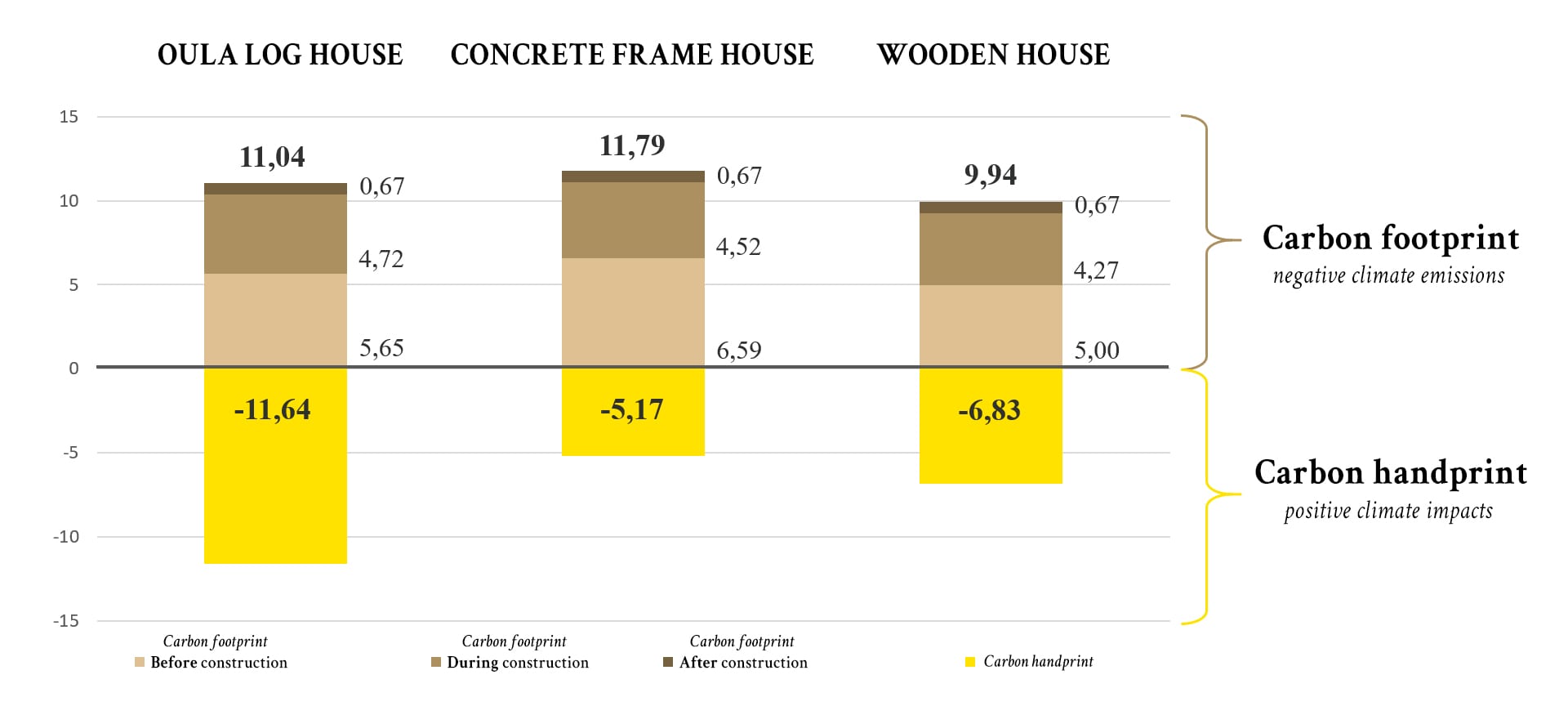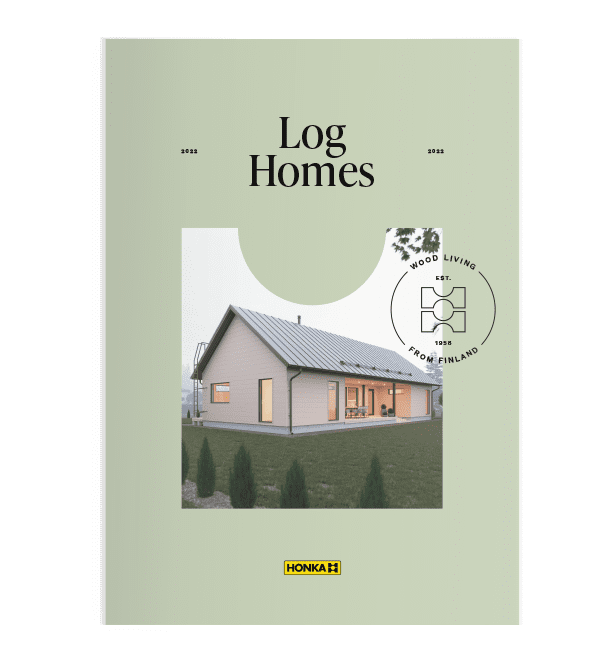The environmental friendliness of buildings can be illustrated by carbon footprint and handprint calculations. We compared our Honka Oula log house to a similarly sized house made of stone and wood. The carbon footprint is almost the same, but there are clear differences in the carbon handprint.
We interviewed Antti Virkkunen, an engineer specialising in carbon footprint calculation at Vesitaito Oy, about environmentally friendly construction. This blog focuses on how calculations can be used to determine whether a house is environmentally friendly with low emissions during its entire life cycle.

What do carbon footprint and carbon handprint mean in practice?
By carbon footprint in a construction project, we refer to the greenhouse gas emissions generated that contribute to global warming. A carbon footprint calculation can determine the amount of emissions a building will generate during its life cycle – from manufacture of the construction products to the point when the building is demolished. This calculation will tell a builder, while still at the design phase, which choices have the lowest emissions.
In addition to carbon footprint, a carbon handprint is calculated for the building, measuring its positive climate impacts. The carbon handprint size depends on carbon absorbed by the structures, and the benefits gained from recycling the construction materials.
The unit of measurement for carbon footprint is called the carbon dioxide equivalent (kgCO2e). This unit measures the warming effect caused by 1 kg of carbon dioxide released into the atmosphere in 100 years. The results of carbon footprint calculation in construction is given as the weight of carbon dioxide equivalents per square metre, divided by the duration of the assessment period. In practice, this unit indicates how many kilogrammes of emissions will be created per square metre in a year. The standard assessment period is 50 years. The unit for the carbon handprint is the same as for the carbon footprint, but the figure is negative.
Carbon footprint calculation is based on an assessment method published by the Ministry of the Environment in Finland on 30 August 2019. The carbon footprint of a building calculated with this method is comparable to the carbon footprint of other Finnish buildings. Emission data is obtained from the environmental declaration, the Ministry of the Environment’s table values and energy performance certificate, among other sources.
In addition to carbon footprint, a carbon handprint is calculated for the building, measuring its positive climate impacts.
Antti Virkkunen
Comparing different building materials – how do log house emissions compare with the corresponding figures of other buildings?
A carbon footprint and handprint provides home builders with a better understanding of what kind of house has genuinely low emissions and is ecological in terms of its environmental impact. This is interesting from the builder’s viewpoint, because the carbon footprints of builders of detached houses may vary considerably, depending on the choice of heating and construction material.
See below for a comparison of the carbon footprints and handprints of three buildings made of three different materials.
130 m2 Honka Oula with geothermal heat
Carbon footprint 11.04 kgCO2e/m²/a,
Total emissions ~66 tCO2e/m2/a
Carbon handprint -11.64 kgCO2e/m²/a,
Positive climate impact ~70 tCO2e/m2/a
130 m2 typical light concrete-frame house with geothermal heat
Carbon footprint 11.79 kgCO2e/m²/a,
Total emissions ~71 tCO2e/m2/a
Carbon handprint -5.17 kgCO2e/m²/a,
Positive climate impact ~31 tCO2e/m2/a
130 m2 typical balloon-framed wooden house with geothermal heat (stud frame)
Carbon footprint 9.94 kgCO2e/m²/a,
Total emissions ~60 tCO2e/m2/a
Carbon handprint -6.83 kgCO2e/m²/a,
Positive climate impact ~41 tCO2e/m2/a
Log house with greatest positive climate impact
As you can see, although the buildings have almost the same carbon footprint, there is a great difference in their handprints. A log house has a clearly bigger carbon handprint, that is, positive climate impact. The greatest benefit is due to the carbon storage of the log house’s timber structure:
According to calculations, logs are the only construction material whose climate benefits are greater than the emissions created. As a tree grows, it accumulates carbon and when a log is used as part of a log house, the carbon remains in the wood instead of warming the climate.
Antti Virkkunen, Vesitaito Oy
How you can affect your construction project’s carbon footprint:
- choice of heating method: geothermal heat pumps are the most energy-efficient
- relief valve for the domestic water network, reducing water consumption
- energy-efficient ventilation unit.
- low air leakage, that is, insulate as well as possible
- simple building shape
- optimal area of windows and doors
- heat-accumulating fireplace
- avoidance of material waste
- low-carbon materials
- construction that meets actual needs; avoidance of extra square metres.
Vesitaito Oy is an innovative and modern engineering company focusing on energy efficiency and life cycle calculation. Vesitaito is the Finnish market leader in the preparation of energy declarations.
Honka’s Environmental Promise
We are committed to:
- Using only Finnish pine from sustainably managed forests
- Ensuring the ecological integrity of our entire production process
- Ensuring the energy efficiency and longevity of our log homes and their environmental friendliness
- Continually working to improve our environmental responsibility
Our vision of sustainable construction
We need a value debate on domestic construction. In too many cases, tight schedules and the pursuit of quick profits win over quality, reason and reflection. What if the key issues were health, a long service life, Finnish origins, the environment, and future generations?
READ MOREHow can we help you?
Share your log home dreams with the nearest Honka representative. We will help you to realise them.
Get in touch



